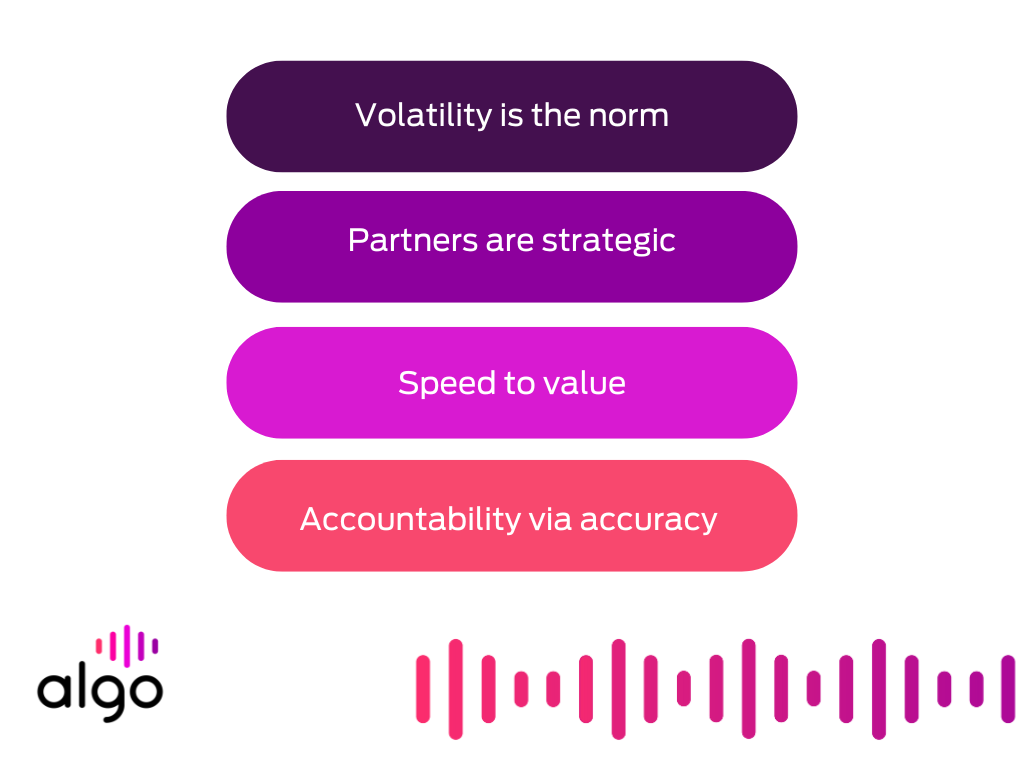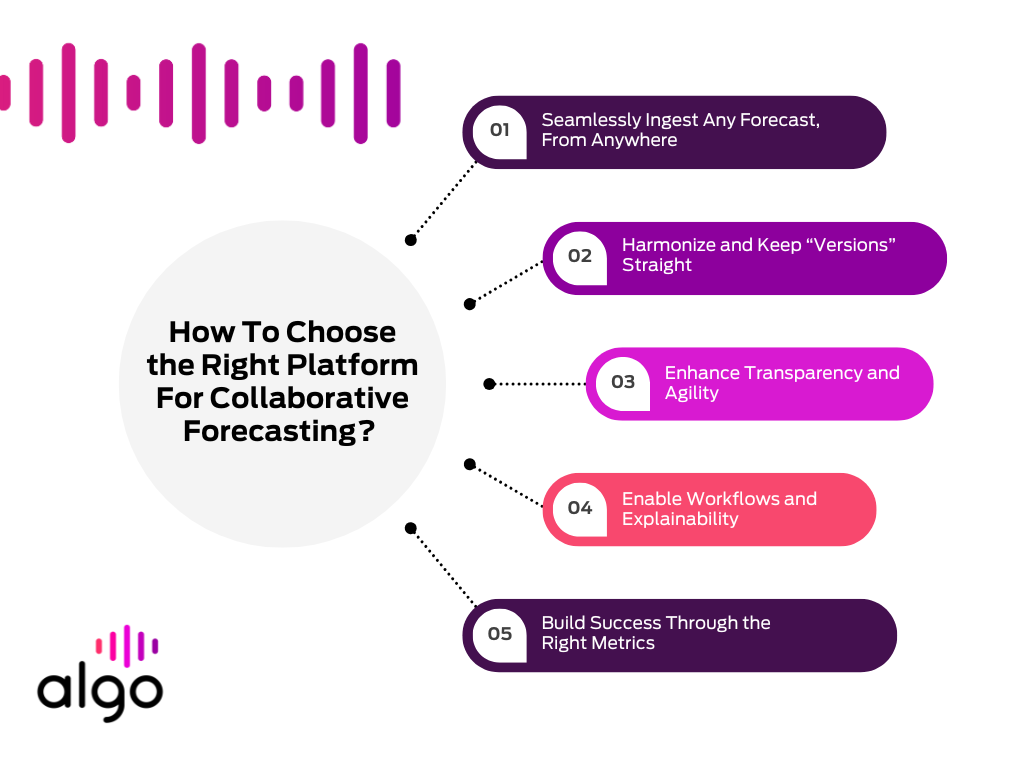Forecasts rarely come from a single source. Your Sales team has a view from the field. Finance has targets. Marketing has promo calendars. Distributors and retailers bring partner signals. Your planning models add a statistical baseline. Modern teams live with multiple “right” forecasts but the problem begins for planners when it is time to pick the one source to go ahead with.
Choosing which to trust (and when), or deciding to create a blend by harmonizing units/calendars, and keeping everything additive across hierarchies is brutally hard to do without a platform that can ingest, compare, and intelligently deliver those inputs consistently, and at speed.
This is where collaborative forecasting comes in. It is the discipline — and the technological capability — of bringing all of those inputs together into one trusted, executable plan in a methodical way.
What is Collaborative Forecasting?
Collaborative forecasting isn’t just a best practice; it’s a necessity. When we break down departmental walls and pool our collective knowledge, we create forecasts that are far more accurate and insightful than anything produced in isolation.
Collaborative forecasting is a structured, repeatable process where multiple contributors—internal teams, external partners, and machine-generated forecasts—submit, review, and reconcile their inputs into a single demand plan. The foundation rests on three non-negotiable pillars:
- Traceability: The ability to audit what change was made, when, and why it was approved.
- Transparency: A clear, understandable view of how the final consensus number was formed from the constituent inputs.
- Governance: Clearly defined roles, ownership, and a structured workflow (submit -> challenge -> approve).
Why Collaborative Forecasting Matters

Think of collaborative forecasting as a symphony, where each section of the orchestra—suppliers, manufacturers, distributors, retailers, and even customers—contributes their unique insights to create a harmonious whole. It’s about dismantling the barriers that traditionally separate these players, fostering open dialogue and data transparency.
- Volatility is the norm: Promotions shift channels, macro signals change quickly, and demand curves bend faster than batch processes can adapt.
- Partners are strategic: Retailers, marketplaces, and distributors often see demand earlier than you do—ignoring their signals costs accuracy.
- Speed to value: Teams need a plan that updates as signals arrive, not weeks later after spreadsheet reconciling.
- Trust and adoption: When contributors can see the lineage of the final forecast, they use it—and decisions move faster.
By blending internal, external, and statistical model signals with clear rules, collaborative forecasting achieves higher accuracy and stability in demand plans, leading to fewer stockouts and markdowns as immediate partner signals shape near-term plans while models anchor the long term; additionally, the consolidation of comments, exceptions, and approvals into a single location enables faster decisions, and the ongoing measurement of accuracy and bias by contributor ensures accountability and continuous improvement across the process.
How to Choose the Collaborative Forecasting Platform

Obaid Farooqi emphasizes that a credible solution “doesn’t bolt collaboration on—it bakes it into planning.” A truly effective platform must handle complexity, ensure transparency, and drive continuous improvement.
When evaluating potential solutions, ensure they offer these five foundational capabilities:
1. Seamless, Multi-Source Forecast Ingestion and Harmonization
A state-of-the-art platform must be able to act as a universal translator, ingesting any signal from any source and preparing it for direct comparison.
- Internal Signals: Must seamlessly capture qualitative and quantitative data from across the organization, including:
-
- Sales call-downs and key account plans.
-
- Finance budget targets and guidance.
-
- Marketing promotional uplift schedules.
-
- Operations constraints and capacity limits.
- External Market Signals: The platform should incorporate real-world external factors that drive demand:
-
- Retailer and distributor forecasts/POS (Point-of-Sale) data.
-
- Syndicated data (e.g., Nielsen, IRI).
-
- Macroeconomic indicators and weather signals.
- Model Outputs: The system needs to integrate various statistical engines:
-
- Statistical baselines (e.g., ARIMA, exponential smoothing).
-
- ML/AI forecasts and predictive analytics.
-
- Causal models that account for specific drivers.
- Practical Ingestion Capabilities: Look for robust technical support, including:
-
- APIs, EDI, and SFTP connections for structured data.
-
- Simple, user-friendly templates or portals for ad-hoc contributor inputs.
-
- Automated schema mapping and essential data quality checks upon intake to prevent “garbage in, garbage out.”
2. Version Control and Data Integrity
A modern platform ensures that while inputs are blended, their integrity and history are never lost. This capability is fundamental to effective governance.
- Maintain Traceable History: The system must maintain historical versions of forecasts alongside notes or comments. This allows users to always answer the crucial questions: “Who changed what, when, and why?”
- Hierarchical Alignment: It must automatically align disparate product/location/customer hierarchies (e.g., SKU to Category, Store to Region) and calendars (e.g., weekly, 4-5-4, monthly).
- Normalization: The platform must normalize units (e.g., cases vs. eaches) and currencies to ensure that comparisons between sources are clean and consistent.
3. Enhanced Transparency and Agility for Reconciliation
The platform should provide the tools necessary for planners to reconcile disparate forecasts quickly and transparently.
- Forecast Accuracy Tracking: Ability to track and display Forecast Accuracy by source and over time, allowing comparison against internal and external benchmarks.
- Hierarchy-Aware Reconciliation: The tool must ensure that totals roll up and down correctly (e.g., the sum of SKUs equals the category total; the sum of weeks equals the monthly total). This is essential for maintaining mathematical consistency across the plan.
- Scenario Comparison: Enable planners to create and compare multiple planning scenarios side-by-side (e.g., “Sales-led,” “Model-led,” “Partner-led”) with instant KPI deltas to quantify the risk and benefit of each strategy.
4. Robust Workflows and Explainability
A good solution turns the reconciliation process into a guided workflow, eliminating the “black box” syndrome often associated with planning.
- Role-Based Workflows: Implement strict submit→review→approve workflows with clearly defined roles, mandatory comments, and Service Level Agreements (SLAs) for timely sign-off.
- Driver Visibility and Attribution: This is critical: stakeholders must understand the “why” behind the final number. The system should highlight real drivers and changes (e.g., a shift in the POS signal changed the near-term plan by 5%) rather than presenting an unexplained output.
- Exception Management: Automated reporting and dashboards must flag demand shifts and significant “forecast vs. actual” divergence so planners can manage by exception, focusing their time on high-impact items.
5. Success Built Through Continuous Measurement
Finally, a dependable planning platform must close the loop, building success through the right metrics that measure process health and business outcomes.
- Granular Accuracy Metrics: Track accuracy and bias by contributor, by time horizon (near-term vs. long-term), and by category to identify systemic areas for process tuning.
- Tying to Business KPIs: Directly link forecast quality back to core business metrics like fill rate, lost sales, inventory turns, and working capital. This translates planning success into financial value.
- Recalibration: The platform should facilitate a continuous improvement cycle by measuring the effectiveness of blending rules and model performance based on what actually happened, ensuring the process keeps improving cycle after cycle.
The Collaborative Forecasting Blueprint: Your Path to Success
Algo was built to orchestrate multi-source forecasting inside the planning workflow — not outside it.
Unified, Multi-Source Ingestion
Connect internal contributors and external partners through APIs, EDI, flat files, or secure portals. Algo harmonizes hierarchies, calendars, units, and currencies on ingest, so you’re comparing like with like from the start.
Blending Flexibility
Blend forecasts by horizon: lean into partner POS near term, statistical baselines longer term, and balance Sales/Finance in the middle. Hierarchy-aware reconciliation keeps everything additive, and scenarios let planners compare strategies with instant KPI deltas.
Governance You Can Trust
Role-based workflows and versioning bake accountability into the process. Explainability tools highlight real drivers behind model output, meaning S&OP meetings can focus on making decisions instead of running calculations.
External Collaboration Without Friction
Give retailers and distributors a simple, secure way to share their signals. Algo validates inputs on the way in, flags anomalies, and shows planners how the partner data compares to other (usually internal) sources before making the final plan — allowing for value-added conversations and collaboration.
From Consensus to Execution
Algo locks the final number without overriding any source data, giving you flexibility to adjust once the plan goes into the execution stage. Key metrics (accuracy, service, inventory) are tracked to help drive improvement cycle after cycle.
Time to Unlock Full Potential of Collaboration
While the path to collaborative forecasting may have its twists and turns, the destination is well worth the journey.
- Start small but focused. Pick a category or region with high impact and visible partner signals.
- Align multiple sources. Baseline model + Sales + Finance + at least one external feed (e.g., POS).
- Set simple rules. Begin with horizon-based rules, order of priority, and clear exception thresholds.
- Measure and tune. Track accuracy and bias by contributor; adjust monthly; scale confidently.
When collaboration is native to the platform, planners stop reconciling spreadsheets and start managing outcomes. Sales trusts the number because they see their inputs and the rationale. Finance trusts the number because it reconciles top-down guidance with bottom-up reality. Partners trust the number because the feedback loop is visible. Leadership trusts the number because the results keep improving.
Remember, collaborative forecasting isn’t a one-time project; it’s a continuous evolution. Stay persistent, stay adaptable, and most importantly, stay collaborative.
And if you need a partner to guide you on this journey, Algo is here to help.
Our supply chain intelligence platform is designed to break down silos, facilitate seamless communication, and empower your teams with the data-driven insights they need to make smarter, faster decisions. We’ll work alongside you to tailor a collaborative forecasting solution that aligns with your unique business needs and industry challenges.
Let’s transform your supply chain together. Contact Algo today to learn more about how we can help you unlock the full potential of collaborative forecasting.
About the author

Obaid Farooqi
Obaid Farooqi is a seasoned supply chain strategist specializing in AI-driven demand planning and forecasting. As a product strategist at Algo, he collaborates with enterprise teams to identify and address the limitations of traditional ERP systems, enhancing visibility and agility across complex supply networks.



